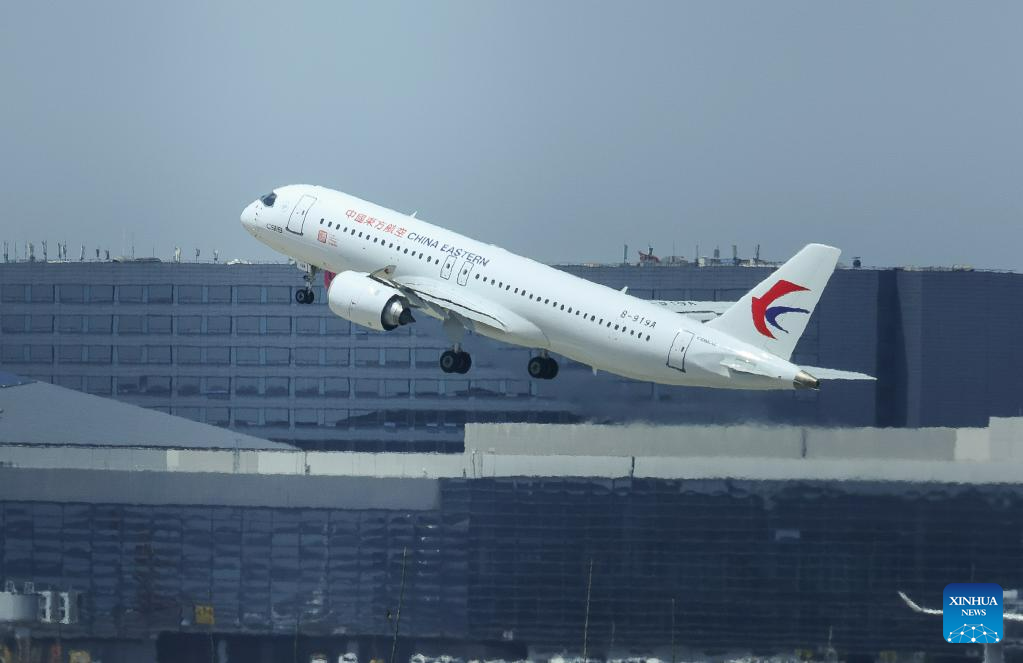
The COMAC C919 completed its first commercial flight on Sunday, May 28. (Photos: COMAC/Xinhua)
The COMAC C919 completed its first commercial flight on Sunday, May 28. Designed to break the duopoly Airbus and Boeing have on commercial aircraft production, the C919 competes directly with the Airbus A320neo and Boeing 737 MAX in the short to medium-haul sector.
The C919 passenger jet received certification approval from the Civil Aviation Administration of China last September. The Commercial Aviation Corp of China (COMAC) originally planned its first delivery and entry into service for 2016, but technical difficulties delayed the program’s commercial service launch several times.
China Eastern Airlines—the launch customer for the new aircraft—operated the type’s first revenue flight. Taking off at 10:45 AM, the flight departed from Shanghai Hongqiao International Airport as MU 9191 and touched down at Beijing Capital Airport just under three hours later. Following its inaugural flight, the aircraft returned to China Eastern’s base in Shanghai.

Pictured above, the C919 lands in Beijing.
While both China Eastern and Comac gave this event little publicity, this flight marks a significant milestone in Comac’s attempt to challenge Airbus and Boeing by competing with their popular narrowbody aircraft. Despite similar sizes and ranges between the C919 and Airbus A320 and Boeing 737, the Comac C919 has picked up just over 1,000 aircraft orders from various operators and firms. Many orders have come from Chinese lessors, but launch customer China Eastern has signed on to operate five of the aircraft type.
China claims the Comac C919 will help it achieve more self-sufficiency, but the aircraft still relies on many Western companies for various parts and avionics. In fact, of the program’s primary suppliers, 60% are United States-based companies. Critical materials like flight recorders, fire detection systems, fuel systems, landing gear, and weather radars are supplied by firms based in the U.S. Aerospace technology corporation Honeywell alone supplied the aircraft’s auxiliary power system, wheels and brakes, flight controls, and navigation controls. The aircraft’s engine, the CFM International LEAP turbofan, comes from a collaboration between GE Aerospace and Safran Aircraft Engines. Meanwhile, Collins Aerospace supplied navigation, surveillance, and communication systems.

China’s C919 made its official entry into the civil aviation market.
Despite foreign dependence on many components of the C919, some are provided by Chinese suppliers. State-owned AVIC Aircraft provides flaps and wing boxes, Western Superconducting Technologies supplies titanium alloys, and Sichuan Chengfei Integration Technology provides several other parts for the aircraft.
The C919 is the largest commercial aircraft ever manufactured in China, and its first commercial flight highlights a significant milestone for Comac as it aims to challenge the Airbus and Boeing duopoly. Though dependent on many Western corporations for critical parts of the aircraft, this accomplishment still marks progress toward China’s goal of self-sufficiency in the aviation sector.
“The first commercial flight is a coming-of-age ceremony of the new aircraft, and C919 will get better and better if it stands the test of the market,” remarked Zhang Xiaoguang, Director of Marketing and Sales at COMAC.